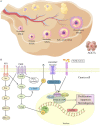Adult-type granulosa cell tumor of the ovary
- PMID: 36119817
- PMCID: PMC9442026
Adult-type granulosa cell tumor of the ovary
Abstract
Adult-type Granulosa Cell Tumor of the Ovary (AGCT) is a relatively rare subtype of ovarian cancer, accounting for 2-4% of all ovarian cancer. AGCT originates from proliferating normal preovulatory granulosa cells (GCs) and retains several features of those GCs. The hormonal features of AGCT explain the clinical manifestations and provide reliable markers for early diagnosis and recurrence prediction of the disease. Most AGCT patients are diagnosed at an early stage and usually demonstrate a better prognosis than patients with other types of ovarian cancer. Surgery is crucial for both initial and post-relapse treatments, whereas adjuvant therapy is still in the exploratory stage. In 2009, a population-based screening makes an exciting step, about 97% of AGCT has somatic missense mutations in the transcription factor FOXL2 gene and the FOXL2 mutation is considered to be a molecular characteristic of AGCT. Unfortunately, the FOXL2 mutation does not fully explain the development of AGCT. Ongoing research is focusing on signalling pathways in the molecular pathogenesis of AGCT to identify the possible pathogenetic factors and signal transduction pathways and provide a theoretical basis for targeted treatment. Postoperative recurrence of ovarian AGCT is common and is associated with a high mortality rate, which necessitates regular follow-up. The life management of postoperative patients is also crucial, which requires multidisciplinary experts to design recurrence treatment from the perspective of patients and implement meaningful treatment measures.
Keywords: Adult-type granulosa cell tumor of the ovary; FOXL2; adjuvant therapy; management; surgery.
AJCR Copyright © 2022.
Conflict of interest statement
None.
Figures




References
-
- Evans AT 3rd, Gaffey TA, Malkasian GD Jr, Annegers JF. Clinicopathologic review of 118 granulosa and 82 theca cell tumors. Obstet Gynecol. 1980;55:231–238. - PubMed
-
- Pectasides D, Pectasides E, Psyrri A. Granulosa cell tumor of the ovary. Cancer Treat Rev. 2008;34:1–12. - PubMed
-
- Fox H, Agrawal K, Langley FA. A clinicopathologic study of 92 cases of granulosa cell tumor of the ovary with special reference to the factors influencing prognosis. Cancer. 1975;35:231–241. - PubMed
-
- Unkila-Kallio L, Tiitinen A, Wahlstrom T, Lehtovirta P, Leminen A. Reproductive features in women developing ovarian granulosa cell tumour at a fertile age. Hum Reprod. 2000;15:589–593. - PubMed
-
- Jamieson S, Fuller PJ. Molecular pathogenesis of granulosa cell tumors of the ovary. Endocr Rev. 2012;33:109–144. - PubMed
Publication types
LinkOut - more resources
Full Text Sources
